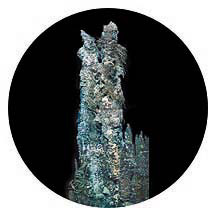An increasing number of scientists are wondering: If it can happen here,
why not somewhere else?
"We recognize that there's a good possibility that life exists in
the solar system outside Earth, but if life does exist, it would be microbial,
not the higher forms," says James Staley, director of the astrobiology
program. As a microbiology
professor, he has made a career of studying microscopic beings and is intrigued
by the prospect that such life on another celestial body could be the forerunner
of intelligent life there.
"We have microbial systems on Earth that are good models for those
on Mars or Europa, and those systems are poorly studied," Staley said.
He expects the astrobiology program to help change that.
The new program comes along just as excitement is being fueled by a succession
of discoveries from more than a dozen planets orbiting nearby stars
to probable liquid water on Europa and Callisto. The UW's program isn't
the first to explore astrobiology; a handful of institutions have some type
of undergraduate programs. Last year, NASA established an Astrobiology Institute,
headquartered near San Francisco, with 11 participating institutions. Though
the UW proposal narrowly missed the cut for financial support from NASA,
Staley, Sullivan and Conway Leovy, an atmospheric
sciences professor who also is an astrobiology co-director, promise
they'll try again. They hope to capitalize on the mounting excitement around
the world and on the UW campus. Meanwhile, the program will go forward with
a five-year, $2 million grant from the National Science Foundation and $500,000
from the University.
A black smoker from the floor of the Pacific. Photo courtesy
of Deborah Kelley, UW School of Oceanography.
Delaney has sparked his share of the excitement surrounding astrobiology
by leading expeditions to thermal vents on the Juan de Fuca Ridge, 180 miles
off the Washington-British Columbia coast. Last summer, Delaney and scientists
from several U.S. and Canadian institutions, including the
American Museum
of Natural History, reeled in four "black smokers" from the ocean
floor more than 8,000 feet below the surface. The sulfide chimneys held
samples of the unusual life found in that unfriendly climate.
Delaney sees a clear tie between his work and astrobiology. "Part
of exploring outer space is understanding what goes on in inner space,"
he says
Jody Deming agrees. She's a deep-sea microbiologist who marvels at the
adaptability of micro-organisms, particularly those locked in polar ice.
Microbes have been on Earth longer than any other creatures, she says, so
if anything can overcome barriers to life, they can.
Close-up pictures of Europa from the Galileo probe draw the oceanography
professor's special interest. "There are lots of features here that
resemble the ice caps on our own planet," Deming says. Surface temperatures
are in the neighborhood of 200 below zero Celsius, and images taken from
high above the surface reveal irregularities. Bubbles in the ice could be
evidence of subsurface thermal activity. Spectroscopy indicates salt content
in some areas, she says, and salt is a good electrical conductor meaning
another potential energy source to support life. And long, squiggly lines
on the surface, she jokes, are evidence of icebreakers plowing through the
frozen landscape.
But Deming also sounds some cautionary notes. Life on Earth has been
found only to about minus 80 degrees Celsius (-110 Fahrenheit), so it could
be that any microbes found on the surface of Europa would lie dormant at
minus 200 (-330 F).
Life also has been found at the greatest pressure known on Earth
about 300 atmospheres, or 300 times greater than the air pressure at sea
level. That's enough force to flatten an Army tank and strain even a heavily
reinforced nuclear submarine. But the pressure on Europa is expected to
be 1,000 atmospheres or more, and no one knows what the upper survival limit
is. "It may be just above what we have on Earth. Then we're out of
business," she says. |
